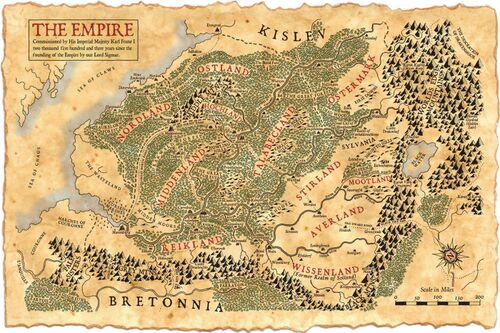Category:Campaign Information
Contents
Setting
Theme
The Enemy Within: The Enemy Within wears a human face, and walks among the everyday folk. While all eyes are on the enemy without, the enemy within walks freely, exchanging cheery greetings with friends and neighbours even as it plots the destruction of the world. Using the distraction of the enemy without to their advantage — the vast and twisted hordes of Chaos that lurk beyond the Empire and Kislev to the north, ready to pour across the border and into the Old World without warning — the enemy within is closer and arguably much more dangerous. The society of the Empire is riddled with Chaos cults, great and small. Some, like the Purple Hand, are widespread, their plans vast and unguessable; others are small and local, and may not even know that they serve the Ruinous Powers. As the Characters progress through the campaign, they become more and more aware that anyone they meet could be an agent of Chaos in disguise.
Human Frailty:
Choices of Evils:
Grim Fantasy: The Enemy Within is a low, dark fantasy; or ‘grubby fantasy’ as we used to call it before such terms were coined. WFRP Characters are often not especially heroic compared to their lethal counterparts in other fantasy games. Instead of gleaming towers of enchanted stone, the buildings of the Empire are half-timbered, huddled tight like the cities of medieval Europe. Magic is known in the world, but it is not widespread, and it’s dangerous to use. Monsters are known to live in the wildernesses between the islands of civilisation, but the most dangerous enemies are often close neighbours, most of whom are all too human.
Style
Grimdark medieval fantasy with slices of dark humor.
Central Tension
TBD
Inciting Incident
TBD
Expectations
- Expect social interactions with both lowborn and nobility/royalty
- Expect brutal combat; anyone can die
- Expect to get caught up in political intrigues well above your pay-grade
- Expect to stay mostly within Reikland borders (for now)
Intended Features
- TBD
Tropes
Reference
- Reference Language: Reikspiel
- Reference Culture: Imperial
Campaign Languages
Nearly all realms that fall within the Imperia region are diglossic: speaking the common tongue for official purposes, or for foreigners, and their local tongue for casual or private conversation (and sometimes when cursing). In the realms of the non-human races, the population tends to speak its own language for all purposes, but are usually capable of also speaking Generic to foreigners. Non-human languages also tend to be more homogenous.
- Reikspiel (aka "Common" for this campaign)
- Bretonnian (think French)
- Classical (think Latin)
- Elthárin (Elf tongue)
- Estalian (think Spanish)
- Khazalid (Dwarf tongue; is taught to no-Dwarfs)
- Magick (required for all spellcasters)
- Tilean (think Italian)
Campaign Cultures
- Imperial (covers the citizens of the Empire)
- Bretonnian (covers ... Bretonnia)
- Non-human (Elvish, Dwarfish, Halfling, etc.)
Common Measurements
Time
- Hours
Sunrise Bell (~06); Midmorning Bell (~09); Noon Bell (~12); Midafternoon Bell (~15); Sunset Bell (~18); Midevening Bell (~21); Midnight Bell (~00); Last Bell (~03)
- Days of the Week
- Angestag (Startweek); Festag (Holyday); Wellentag (Workday); Aubentag (Levyday); Bezahltag (Taxday); Konistag (Kingday)
- Months
The dating system splits the 400-day year into twelve months of 32 or 33 days, and includes six important festival days, each of which lie between the months.
- The twelve months of the year are: Nachexen (After-Witching), Jahrdrung (Year-Turn), Pflugzeit (Ploughtide), Sigmarzeit (Sigmartide), Sommerzeit (Summertide), Vorgeheim (Fore-Mystery), Nachgeheim (After-Mystery), Erntezeit (Harvest-tide), Brauzeit (Brew month), Kaldezeit (Chill month), Ulriczeit (Ulric-tide), and Vorhexen (Fore-Witching).
- The six extra days in the year are: Hexenstag (Witching Day – New Year's Day), Mitterfruhl (Start Growth – Spring Equinox), Sonnstill (Sun Still – Summer Solstice), Geheimnistag (Day of Mystery), Mittherbst (Less Growth – Autumn Equinox), and Mondstille (World Still – Winter Solstice).
- Years
- The Imperial Calendar is dated from the year of Sigmar's coronation as the first emperor, which serves as the year 1 Imperial Calendar (I.C.); the current year is 2512 I.C.
- Other
- Fortnight (2-weeks)
Distance
- Rod
- The rod is a historical unit of length equal to 5½ yards. It may have originated from the typical length of a mediaeval ox-goad.
- Chain
- 4 rods (66 feet or 22 yards).
- Furlong
- (meaning furrow length) the distance a team of oxen could plough without resting. This was standardised to be exactly 40 rods or 10 chains.
- Acre
- four by 40 rods. An acre was the amount of land tillable by one man behind one ox in one day. Traditional acres were long and narrow due to the difficulty in turning the plough and the value of river front access.
- Mile
- 8 furlongs
- League
- the distance a person could walk in an hour, most commonly defined as three miles.
Currency
- Brass Penny (d) = $1 ($62.50/lb.)
- Silver Shilling (/) = $12 ($1,000/lb.)
- Gold Crown (GC) = $240 ($20,000/lb.)
Notes:
- 1 gold crown (1GC) = 20 silver shillings (20/-) = 240 brass pennies (240d)
- 1 silver shilling (1/-) = 12 brass pennies (12d)
- Abbreviated to 1GC = 20/- = 240d
Miscellaneous
- Renaissance era tech, including guns
Pages in category "Campaign Information"
This category contains only the following page.
